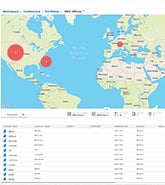The change management process for a (re)insurer – with updating risk models and associated downstream workflows – is becoming increasingly complex, costly, and time-consuming.
Running on the most up-to-date view of risk as provided by your model vendor, whether it is to gain a competitive advantage or responding to a regulatory requirement, makes change management unavoidable. Whether a (re)insurer uses an on-premises or software as a service (SaaS) solution, having the latest view of risk is a necessity to best serve your customers and internal stakeholders.
How are (re)insurers looking to address these change management issues? Our clients are adopting applications such as RMS® Risk Modeler™ and leveraging its cloud-native architecture. In doing so, they dramatically reduce the pain of implementing new or updated risk models, especially those traditionally deployed in on-premises environments.
Risk model change management currently impacts many areas of a (re)insurer’s business. This blog examines the role of IT in the risk model change management process and the significant resources required to do this – which is obviously just one part of their overall workload. Dedicating time, capacity, and support drives up costs. So more importantly, we’ll also discuss how an intelligent SaaS solution can eliminate both the direct and indirect costs of updating to the most recent view of risk.
This blog is part of a series focusing on the impact of change management within a risk organization. In future blogs, we’ll dive into how change management is specifically seen as an important driver for many new and existing RMS customers that are looking to adopt SaaS solutions, such as Risk Modeler.
Defining Hidden IT Costs
One of the major costs of an internal risk model change management and validation process for on-premises solutions lies with the building and maintenance of the required IT infrastructure and any subsequent migration between IT systems, to ensure a seamless transition to the newest risk model.
To achieve this end-to-end process using an on-premises system, a useful analogy is to visualize an iceberg. Direct hardware costs, such as building a new IT environment, are the most visible part of the iceberg. But below the surface, hidden costs abound as there are many unavoidable steps required just to reach a production-ready state for a model upgrade – and this is all before the catastrophe modelers begin the model validation process.
New costs for building an IT environment include the time and expertise involved, together with the pressure to deliver. This introduces operational risks, creating several time-critical steps to be planned around key business activities.
Just a few of those additional hidden costs to your organization include:
- Budget planning for any new hardware requirements: Your risk modelers must establish the scope of the environment needed to support the IT team. This can be time-consuming and takes you away from your core work as you conduct many meetings with IT, submit a budget, and understand the interplay of IT resources (outside consultants or internal stakeholders). Every minute planning for and attending these meetings is one fewer minute dedicated to another, higher-value activity.
- Installation and upgrade of a user acceptance testing (UAT) environment: Typically, a separate UAT is created to avoid impacts to the business-as-usual (BAU) live production environment. For this, hardware needs to be purchased and IT resources secured, with IT teams dedicating a significant amount of time to build the new environment.
- Perform user acceptance testing: Before your business and your modelers can begin model validation, IT needs to ensure the system performs as expected for functionality, performance, and replication of expected results. IT will often conduct many days of testing of the new environments.
- Maintenance and upkeep: Once the second IT environment is built, IT will be responsible for both the production environment of the current model and the testing environment for the new model. This could mean double the support tickets for your IT organization.
There is constant pressure as each of these activities incurs both a time and cost penalty just to get to a testing- and production-ready state for a new model before any validation steps, which can then further impact time constraints. Next, installation work for the BAU environment(s) will need to be carefully planned around business needs to avoid system outages at critical times.
This all assumes everything goes smoothly. If not, there is also the risk that unplanned issues are found during this process, which can cause further system outages, create unplanned costs, and interrupt BAU activities.
Cloud-Native Risk Modeling Improves Total Cost of Ownership
SaaS solutions such as the RMS Risk Modeler application now present a significant opportunity. They can dramatically reduce both direct and indirect IT costs related to updating or implementing a new model into your business processes. Unlike traditional on-premises IT solutions, with Risk Modeler there is no requirement to buy IT infrastructure or dedicate significant IT resources to support your change management process.
This means weeks (and possibly months) of planning, purchase, and installation of IT hardware can be completely removed – while also eliminating the associated operational risks that are introduced with any on-premises upgrade. In short, new hardware installation or management of two separate modeling environments is simply not needed.
Instead, your catastrophe modeling and analytics team has access to multiple versions of the same model in one environment, and all the issues around updates, patches, and bugs are managed by RMS. Using a simple drop-down menu, all versions of your model are available to run, leveraging the same workflows to reduce the time and effort for testing. When RMS releases a new model, you can immediately begin the validation process rather than waiting on IT to build a new system for testing.
Learn more about the Risk Modeler application, and please join us for part two in this blog series. Next time, we’ll discuss how Risk Modeler can simplify the model validation process and accelerate the time to bring new models into your production processes.






